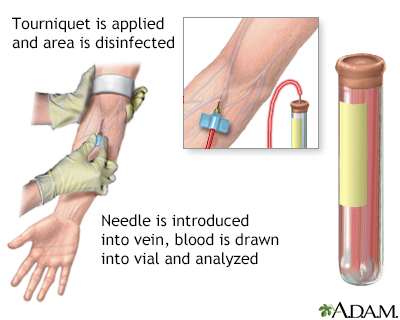ESR
ESR stands for erythrocyte sedimentation rate. It is commonly called a "sed rate."
It is a test that indirectly measures the level of certain proteins in the blood. This measurement correlates with the amount of inflammation in the body.
How the Test is Performed
A blood sample is needed. Most of the time, blood is drawn from a vein located on the inside of the elbow or the back of the hand. The blood sample is sent to a lab.
Drawn from a vein
Venipuncture is the collection of blood from a vein. It is most often done for laboratory testing.

The test measures how fast red blood cells (called erythrocytes) fall to the bottom of a tall, thin tube.
How to Prepare for the Test
There are no special steps needed to prepare for this test.
How the Test will Feel
You may feel slight pain or a sting when the needle is inserted. You may also feel some throbbing at the site after the blood is drawn.
Why the Test is Performed
Reasons why a "sed rate" may be done include:
- Unexplained fevers
- Certain types of joint pain or arthritis
- Muscle symptoms
- Headache
- Other vague symptoms that cannot be explained
This test may also be used to monitor whether an illness is responding to treatment.
This test can be used to monitor inflammatory diseases or cancer. It is not used to diagnose a specific disorder.
However, the test is useful for detecting and monitoring:
- Autoimmune disorders
- Bone infections
- Certain forms of arthritis
- Inflammatory diseases
Normal Results
For adults (Westergren method):
- Men under 50 years old: less than 15 mm/hr
- Men over 50 years old: less than 20 mm/hr
- Women under 50 years old: less than 20 mm/hr
- Women over 50 years old: less than 30 mm/hr
For children (Westergren method):
- Newborn: 0 to 2 mm/hr
- Newborn to puberty: 3 to 13 mm/hr
Note: mm/hr = millimeters per hour
Normal value ranges may vary slightly among different laboratories. Talk to your health care provider about the meaning of your specific test results.
What Abnormal Results Mean
An abnormal ESR may help with a diagnosis, but it does not prove that you have a certain condition. Other tests are almost always needed.
An increased ESR rate may occur in people with:
- Anemia
- Cancers such as lymphoma or multiple myeloma
- Kidney disease
- Pregnancy
- Thyroid disease
The immune system helps protect the body against harmful substances. An autoimmune disorder is when the immune system mistakenly attacks and destroys healthy body tissue. ESR is often higher than normal in people with an autoimmune disorder.
Common autoimmune disorders include:
- Lupus
- Polymyalgia rheumatica
- Rheumatoid arthritis in adults or children
Very high ESR levels occur with less common autoimmune or other disorders, including:
- Allergic vasculitis
- Giant cell arteritis
Giant cell arteritis
Giant cell arteritis (GCA) is inflammation and damage to the blood vessels that supply blood to the head, neck, upper body and arms. It is also call...
 ImageRead Article Now Book Mark Article
ImageRead Article Now Book Mark Article - Hyperfibrinogenemia (increased fibrinogen levels in the blood)
- Macroglobulinemia - primary
- Necrotizing vasculitis
Necrotizing vasculitis
Necrotizing vasculitis is a group of disorders that involve inflammation of the blood vessel walls. The size of the affected blood vessels helps to ...
 ImageRead Article Now Book Mark Article
ImageRead Article Now Book Mark Article
An increased ESR rate may be due to some infections, including:
- Bodywide (systemic) infection
- Bone infections
- Infection of the heart or heart valves
Infection of the heart or heart valves
Endocarditis is inflammation of the inside lining of the heart chambers and heart valves (endocardium). It is most often caused by a bacterial or, r...
 ImageRead Article Now Book Mark Article
ImageRead Article Now Book Mark Article - Rheumatic fever
Rheumatic fever
Rheumatic fever is a disease that may develop after an infection with group A streptococcus bacteria (such as strep throat or scarlet fever). It can...
Read Article Now Book Mark Article - Severe skin infections, such as erysipelas
- Tuberculosis
Lower-than-normal levels occur with:
- Congestive heart failure
Congestive heart failure
Heart failure is a condition in which the heart is no longer able to pump oxygen-rich blood to the rest of the body efficiently. This causes symptom...
 ImageRead Article Now Book Mark Article
ImageRead Article Now Book Mark Article - Hyperviscosity
- Hypofibrinogenemia (decreased fibrinogen levels)
- Leukemia
- Low plasma protein (due to liver or kidney disease)
- Polycythemia
- Sickle cell anemia
Reviewed By
Jacob Berman, MD, MPH, Clinical Assistant Professor of Medicine, Division of General Internal Medicine, University of Washington School of Medicine, Seattle, WA. Also reviewed by David C. Dugdale, MD, Medical Director, Brenda Conaway, Editorial Director, and the A.D.A.M. Editorial team.
Deane KD, Pisetsky DS. Laboratory testing in the rheumatic diseases. In: Goldman L, Cooney KA, eds. Goldman-Cecil Medicine. 27th ed. Philadelphia, PA: Elsevier; 2024:chap 237.
Vajpayee N, Graham SS, Bem S. Basic examination of blood and bone marrow. In: McPherson RA, Pincus MR, eds. Henry's Clinical Diagnosis and Management by Laboratory Methods. 24th ed. Philadelphia, PA: Elsevier; 2022:chap 31.




